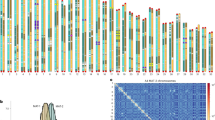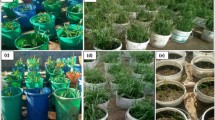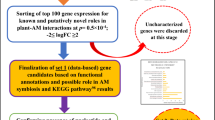Abstract
Arbuscular mycorrhizal fungi (AMF) are among the most abundant symbionts of plants, improving plant productivity and diversity. They are thought to mostly grow vegetatively, a trait assumed to limit adaptability. However, AMF can also harbor genetically different nuclei (nucleotypes). It has been shown that one AMF can produce genotypically novel offspring with proportions of different nucleotypes. We hypothesized that (1) AMF respond rapidly to a change of environment (plant host) through changes in the frequency of nucleotypes; (2) genotypically novel offspring exhibit different genetic responses to environmental change than the parent; and (3) genotypically novel offspring exhibit a wide range of phenotypic plasticity to a change of environment. We subjected AMF parents and offspring to a host shift. We observed rapid and large genotypic changes in all AMF lines that were not random. Genotypic and phenotypic responses were different among offspring and their parents. Even though growing vegetatively, AMF offspring display a broad range of genotypic and phenotypic changes in response to host shift. We conclude that AMF have the ability to rapidly produce variable progeny, increasing their probability to produce offspring with different fitness than their parents and, consequently, their potential adaptability to new environmental conditions. Such genotypic and phenotypic flexibility could be a fast alternative to sexual reproduction and is likely to be a key to the ecological success of AMF.
Similar content being viewed by others
Log in or create a free account to read this content
Gain free access to this article, as well as selected content from this journal and more on nature.com
or
References
Angelard C, Colard A, Niculita-Hirzel H, Croll D, Sanders IR . (2010). Segregation in a mycorrhizal fungus alters rice growth and symbiosis-specific gene transcription. Curr Biol 20: 1216–1221.
Angelard C, Sanders IR . (2011). Effect of segregation and genetic exchange on arbuscular mycorrhizal fungi in colonization of roots. New Phytol 189: 652–657.
Bates DM, Sarkar D . (2007), Lme4: Linear mixed-effects models using S4 classes. R package version 0.999999-0.
Bécard G, Fortin JA . (1988). Early events of vesicular arbuscular mycorrhiza formation on Ri T-DNA trnasformed roots. New Phytol 108: 211–218.
Bécard G, Piche Y . (1992). Establishment of vesicular-arbuscular mycorrhiza in root organ culture - Review and proposed methodology. Methods Microbiol 24: 89–108.
Burt A . (2000). Sex, recombination and the efficacy of selection - was Weissman right? Evolution 54: 337–351.
Croll D, Sanders IR . (2009). Recombination in Glomus intraradices, a supposed ancient asexual arbuscular mycorrhizal fungus. BMC Evol Biol 9: 13.
Croll D, Giovannetti M, Koch AM, Sbrana C, Ehinger M, Lammers PJ et al (2009). Nonself vegetative fusion and genetic exchange in the arbuscular mycorrhizal fungus Glomus intraradices. New Phytol 181: 924–937.
Drigo B, Pijl AS, Duyts H, Kielak A, Gamper HA, Houtekamer MJ et al (2010). Shifting carbon flow from roots into associated microbial communities in response to elevated atmospheric CO2. Proc Nat Acad Sci 107: 10938–10942.
Ehinger M, Croll D, Koch MA, Sanders IR . (2012). Significant genetic and phenotypic changes arising from clonal growth of a single spore of an arbuscular mycorrhizal fungus over multiple generations. New Phytol 196: 853–861.
Ehinger M, Koch AM, Sanders IR . (2009). Changes in arbuscular mycorrhizal fungal phenotypes and genotypes in response to plant species identity and phosphorus concentration. New Phytol 184: 412–423.
Fox J . (2008) Applied Regression analysis and Generalized Linear Models 2nd edn. Sage Publications: Thousand Oaks, CA, USA.
Fox J, Weisberg S . (2011) An R companion to applied regression 2nd edn. Sage Publications: Thousand Oaks, CA, USA.
Halary S, Malik S-B, Lildhar L, Slamovits CH, Hijri M, Corradi N . (2011). Conserved meiotic machinery in Glomus spp., a putatively ancient asexual fungal lineage. Genome Biol Evol 3: 950–958.
Harrison MJ . (1997). The arbuscular mycorrhizal symbiosis: An underground association. Trends Plant Sci 2: 54–60.
Hickman MA, Zeng G, Forche A, Hirakawa MP, Abbey D, Harrison BD et al (2013). The ‘obligate diploid' Candida albicans forms mating-competent haploids. Nature 494: 55–59.
Hijri M, Sanders IR . (2005). Low gene copy number shows that arbuscular mycorrhizal fungi inherit genetically different nuclei. Nature 433: 160–163.
Johnson NC, Angelard C, Sanders IR, Kiers ET . (2013). Predicting community and ecosystem outcomes of mycorrhizal responses to global change. Ecol Lett 16: 140–153.
Judson OP, Normark BB . (1996). Ancient asexual scandals. Trends Ecol Evol 11: 41–46.
Koch AM, Croll D, Sanders IR . (2006). Genetic variability in a population of arbuscular mycorrhizal fungi causes variation in plant growth. Ecol Lett 9: 103–110.
Koch AM, Kuhn G, Fontanillas P, Fumagalli L, Goudet J, Sanders IR . (2004). High genetic variability and low local diversity in a population of arbuscular mycorrhizal fungi. Proc Nat Acad Sci USA 101: 2369–2374.
Krüger M, Krüger C, Walker C, Stockinger H, Schussler A . (2012). Phylogenetic reference data for systematics and phylotaxonomy of arbuscular mycorrhizal fungi from phylum to species level. New Phytol 193: 970–984.
Kuhn G, Hijri M, Sanders IR . (2001). Evidence for the evolution of multiple genomes in arbuscular mycorrhizal fungi. Nature 414: 745–748.
Manly BFJ . (2007) Randomization, Bootstrap, and Monte Carlo Methods in Biology 3rd edn. Chapman and Hall: London, UK.
Newcombe RG . (1998). Interval estimation for the difference between independent proportions: comparison of eleven methods. Stat Med 17: 873–890.
Pinheiro JC, Bates DM . (2000) Mixed-effects models in S and S-PLUS. Springer: New York, NY, USA.
Pringle A, Taylor JW . (2002). The fitness of filamentous fungi. Trends Microbiol 10: 474–481.
Redecker D, Kodner R, Graham LE . (2000). Glomalean fungi from the Ordovician. Science 289: 1920–1921.
Rosendahl S, Stuckenbrock EH . (2004). Community structure of arbuscular mycorrhizal fungi in undisturbed vegetation revealed by analyses of LSU rDNA sequences. Mol Ecol 13: 3179–3186.
Sanders IR, Croll D . (2010). Arbuscular mycorrhiza: The challenge to understand the genetics of the fungal partner. Annu Rev Genet 44: 271–292.
Smith SE, Read DJ . (2008) Mycorrhizal Symbiosis. Academic Press: San Diego, CA, USA.
Sokal RR, Rohlf FJ . (1995) Biometry: The principles and practice of statistics in biological research 3rd edn. W.H. Freeman and Co: New York, NY, USA.
St-Arnaud M, Hamel C, Vimard B, Caron M, Fortin JA . (1996). Enhanced hyphal growth and spore production of the arbuscular mycorrhizal fungus Glomus intraradices in an in vitro system in the absence of host roots. Mycol Res 100: 328–332.
Stearns SC . (1992) The Evolution of Life Histories. Oxford University Press: Oxford, UK.
Stockinger H, Walker C, Schussler A . (2009). ‘Glomus intraradices DAOM197198', a model fungus in arbuscular mycorrhiza research, is not Glomus intraradices. New Phytol 183: 1176–1187.
van der Heijden MGA, Klironomos JN, Ursic M, Moutoglis P, Streitwolf-Engel R, Boller T et al (1998). Mycorrhizal fungal diversity determines plant biodiversity, ecosystem variability and productivity. Nature 396: 69–72.
Weismann A . (1889). The significance of sexual reproduction in the theory of natural selection. In: SSEB Poulton, Shipley AE (eds) Essays upon heredity and kindred biological problems. Clarendon Press: Oxford, UK.
Weismann A . (1904) The Evolution Theory. Edward Arnold: London, UK.
Acknowledgements
We thank M Bucher (University of Cologne) and G Bécard (University Paul Sabatier, Toulouse) for supplying roots and Jeremy Bonvin for help with DNA extraction and molecular analyses. We also thank T Kiers, T Kawecki and J Goudet for constructive comments on this work. This work was supported by a grant from the Swiss National Science Foundation (310030B_144079/1). Correspondence and request for materials should be addressed to IRS (ian.sanders@unil.ch).
Author information
Authors and Affiliations
Corresponding author
Ethics declarations
Competing interests
The authors declare no conflict of interest.
Additional information
Supplementary Information accompanies this paper on The ISME Journal website
Supplementary information
Rights and permissions
About this article
Cite this article
Angelard, C., Tanner, C., Fontanillas, P. et al. Rapid genotypic change and plasticity in arbuscular mycorrhizal fungi is caused by a host shift and enhanced by segregation. ISME J 8, 284–294 (2014). https://doi.org/10.1038/ismej.2013.154
Received:
Revised:
Accepted:
Published:
Issue date:
DOI: https://doi.org/10.1038/ismej.2013.154
Keywords
This article is cited by
-
Stochastic nuclear organization and host-dependent allele contribution in Rhizophagus irregularis
BMC Genomics (2023)
-
Dual RNA-seq reveals large-scale non-conserved genotype × genotype-specific genetic reprograming and molecular crosstalk in the mycorrhizal symbiosis
The ISME Journal (2019)
-
Maize varieties can strengthen positive plant-soil feedback through beneficial arbuscular mycorrhizal fungal mutualists
Mycorrhiza (2019)
-
Herbivore removal reduces influence of arbuscular mycorrhizal fungi on plant growth and tolerance in an East African savanna
Oecologia (2018)
-
Divergence of Funneliformis mosseae populations over 20 years of laboratory cultivation, as revealed by vegetative incompatibility and molecular analysis
Mycorrhiza (2018)



